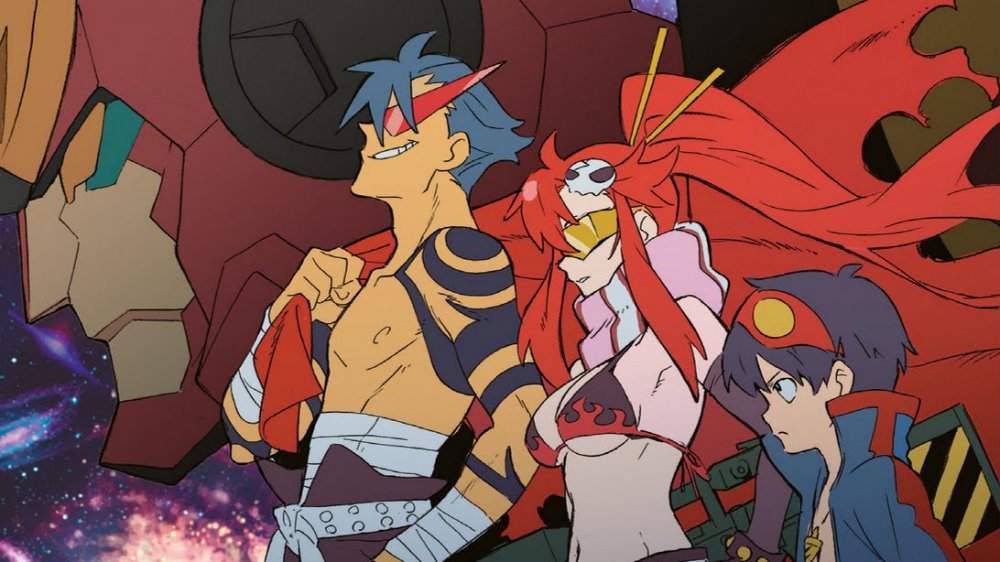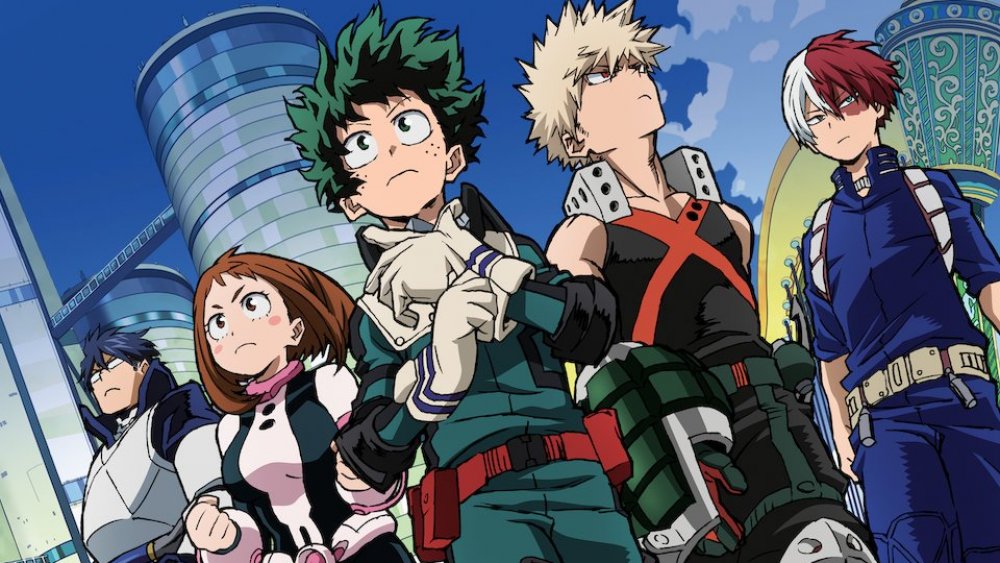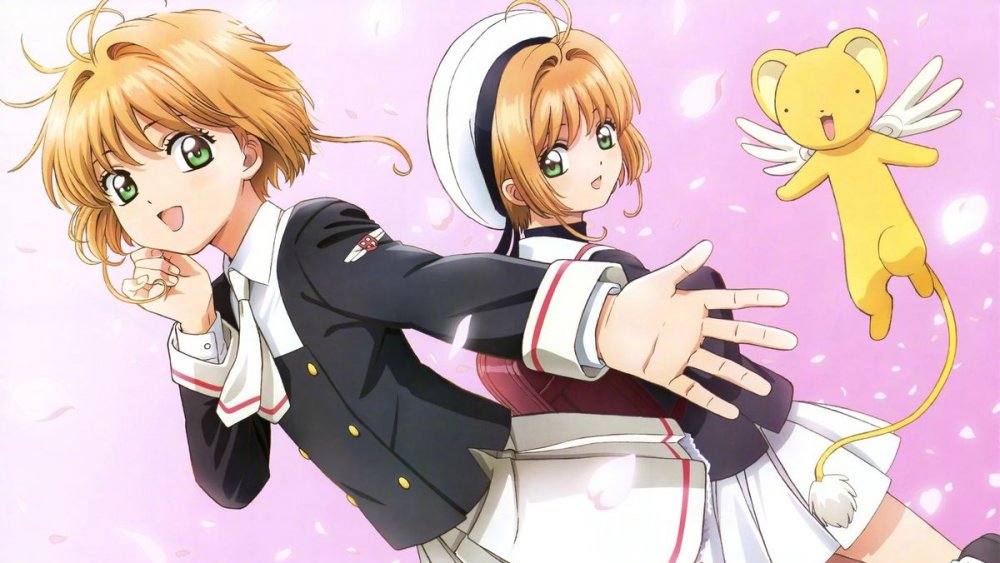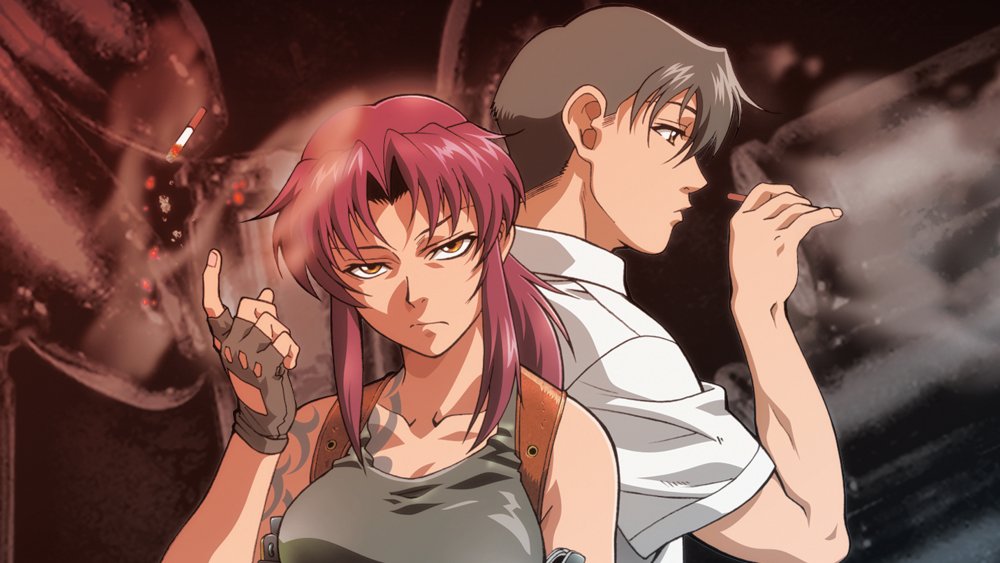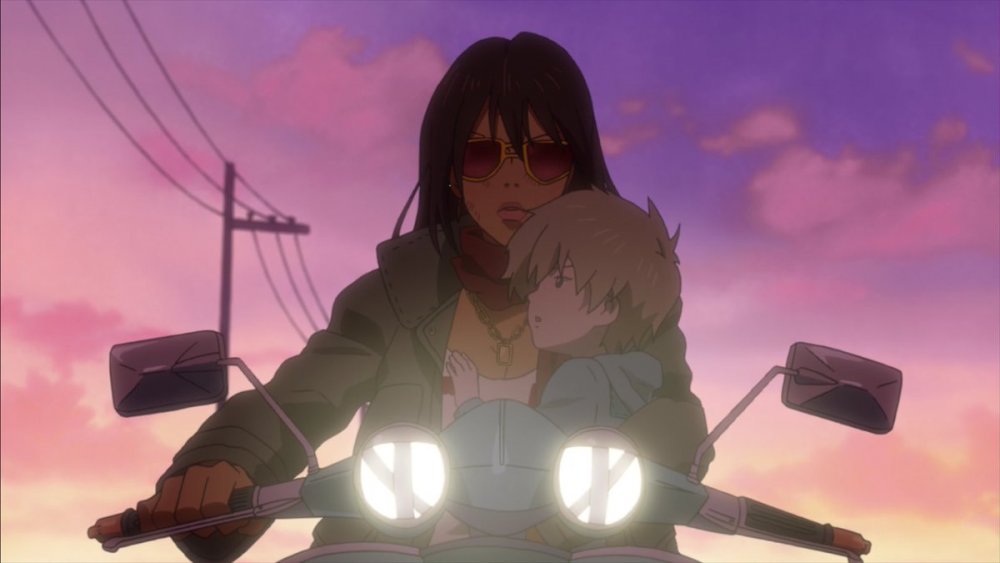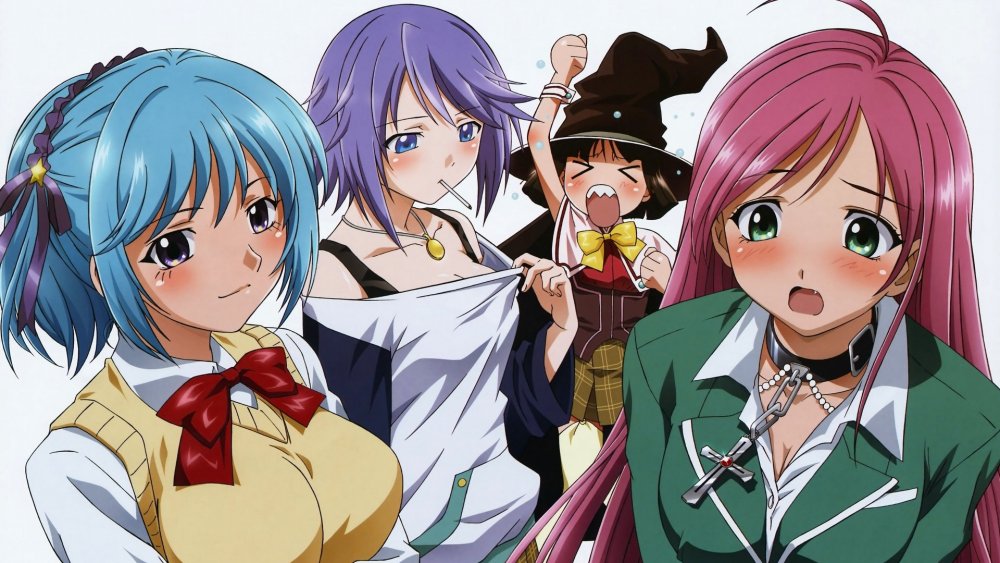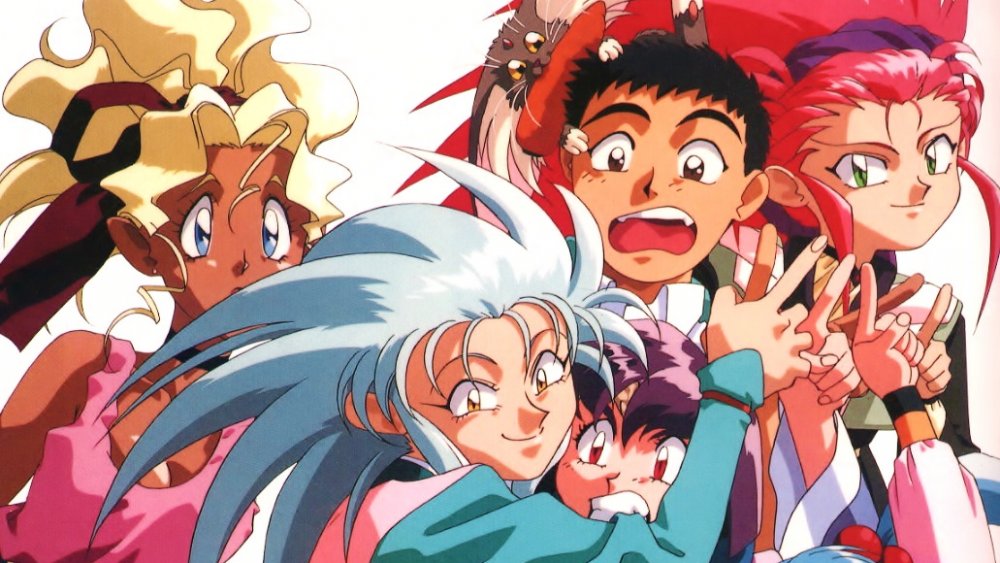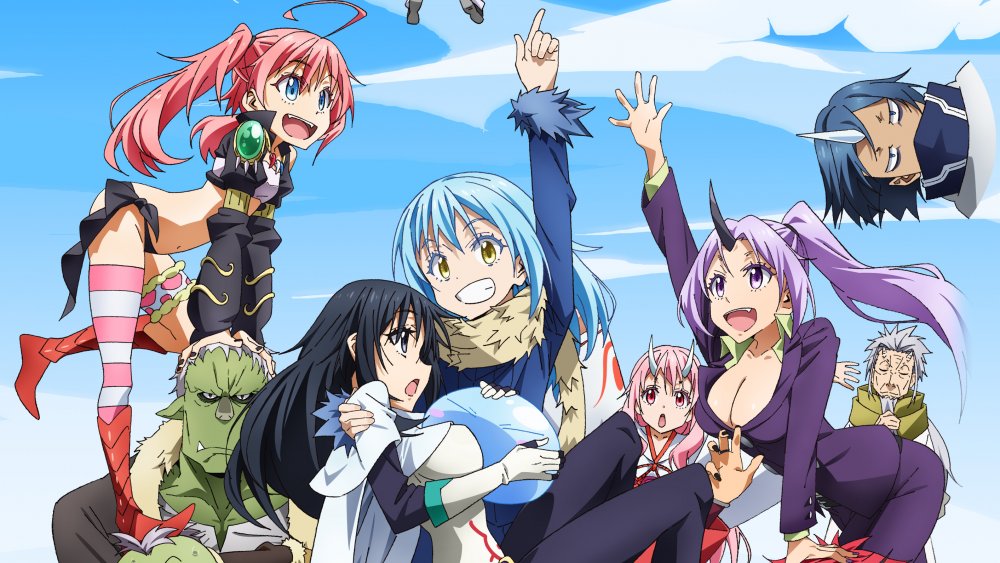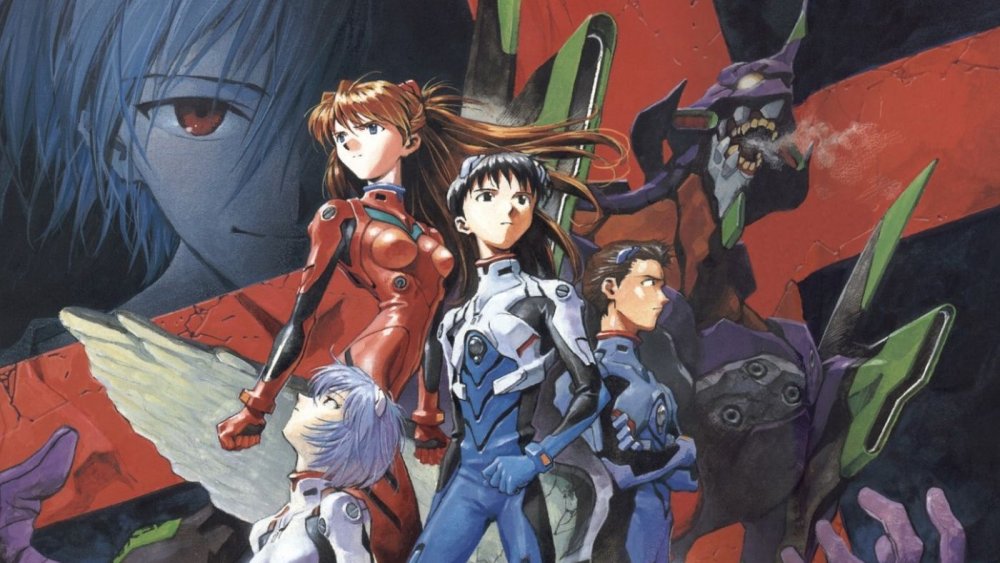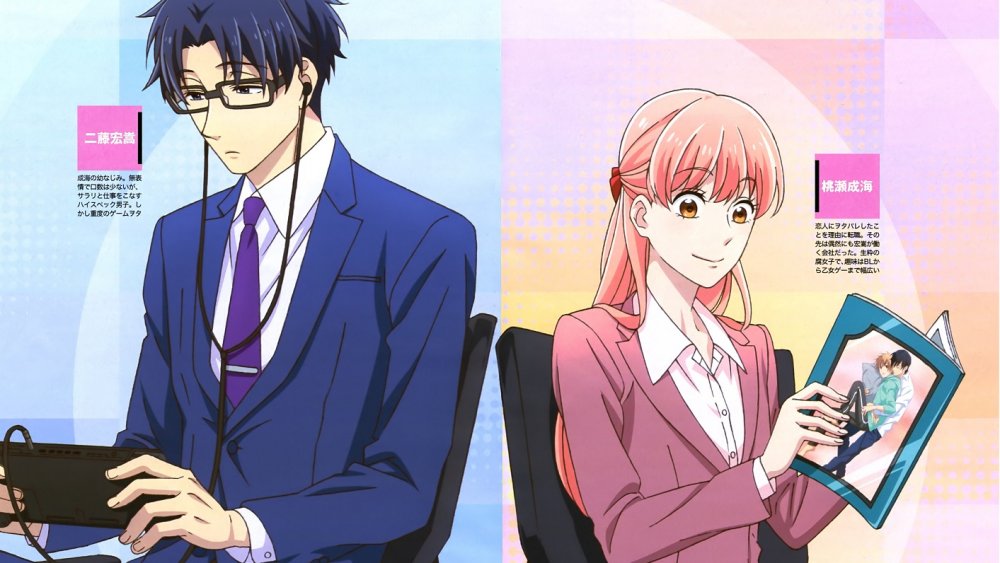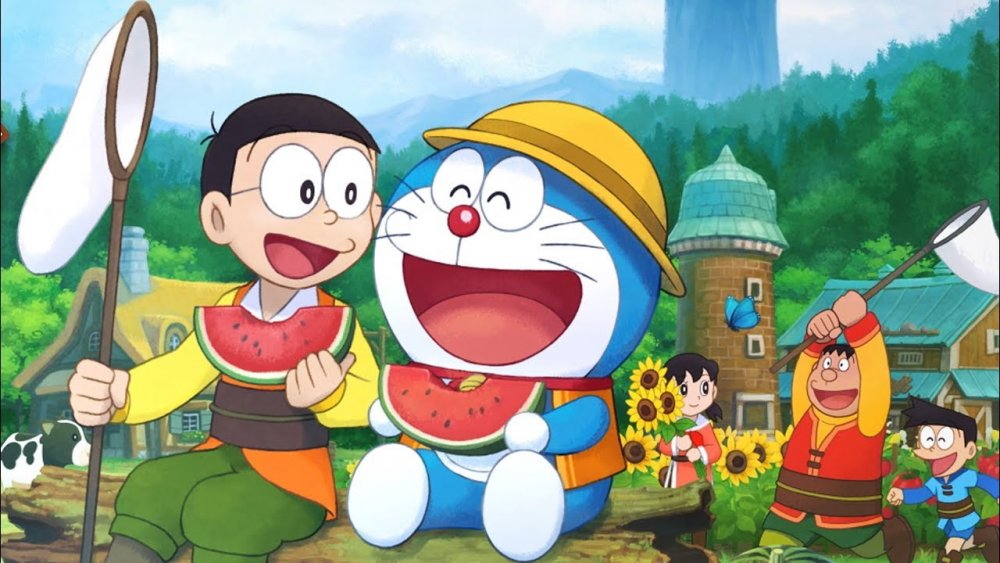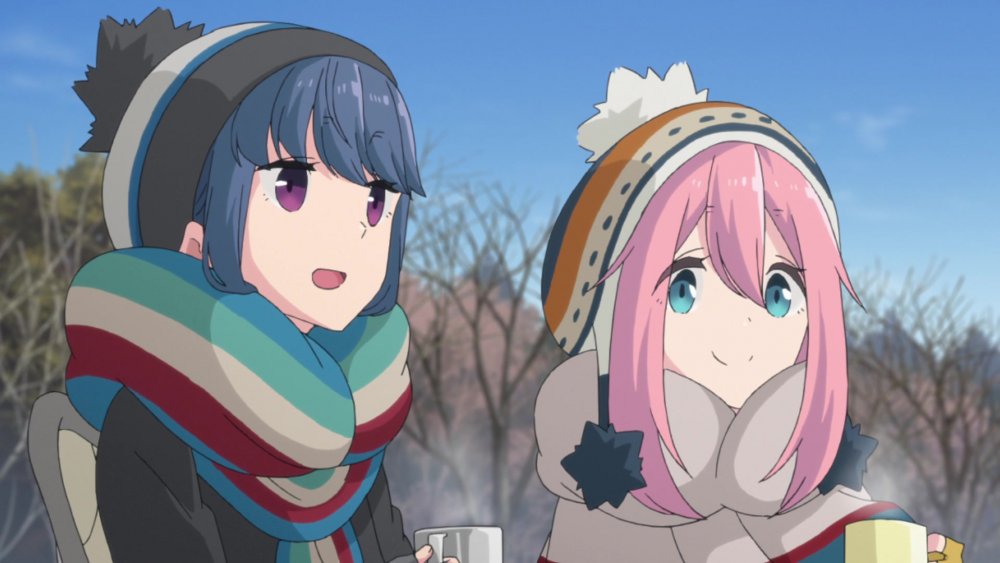Anime Genres Explained
In a world where there's a Studio Ghibli Fathom Event every month, and Halloween means glimpsing more than a few four-foot-tall Vegetas wandering around, anime is no longer obscure. These days, NFL players present the Crunchyroll Anime Awards, Ariana Grande has "Pokemon" and "Spirited Away" tattoos, and there's a live-action "One Piece" adaptation out that people actually like. Yet, just because anime has become mainstream, that doesn't mean viewers in the English-speaking world know the medium inside and out.
Genre descriptors used for anime are one thing that might require some explaining. Anime can cover basically any genre, and obviously Americans will know what to expect if they hear an anime is, say, a comedy or a science fiction drama. But then there are other genre descriptors that are unique to Japanese media, or terms that have different implications in the context of anime versus in other media.
Below, a primer on these major genres of anime, for demystification needs as well as examples of anime various categories and how to stream them in the United States. Get ready to learn about all the different sorts of giant robots a hot-headed teen protagonist can find himself piloting, and all the different genres in which it can be done.
Every type of anime
- Shonen
- Shoujo
- Seinen
- Josei
- Ecchi
- Harem
- Isekai
- Mecha
- Slice of Life
- Kodomomuke
- Iyashikei
Shonen
When you think of anime, what comes to mind is likely shonen. "My Hero Academia," "Dragon Ball Z," "Slam Dunk" — all of it is comfortably shonen, despite how widely those titles might vary. That's because shonen really just means "for boys," making it more of a demographic category than a genre. In the age of anime as export, however, the term has gained genre connotations that cannot be ignored. When a kid loves "Bleach" and wants to read something else in that vein, he's going to end up searching for "shonen" — and generally speaking, he's going to find something new to love.
Shonen anime encompasses an enormous variety of subgenres: Sports, fantasy, science fiction, and even horror stories are found beneath this umbrella. Compare something like "Tengen Toppa Gurren Lagann," a candy-colored giant robot story, against "Eyeshield 21," which follows a high school football team on their way to sports stardom. They feature wildly different motifs, storylines, and settings, and yet they are both solidly shonen. What unites them, and all shonen anime, is a focus on young men, often seeking to become the best at what they do, to right a terrible wrong, and/or to protect the ones they love. These are passionate, idealistic stories about youth at its most zealous, full of action and heart. It's no wonder that shonen is the most popular genre of anime — who can resist a hot-blooded do-gooder, whether he's a rookie shortstop, pirate captain, or wannabe pilot?
Examples of shonen anime:
- "One Piece" (streaming on Crunchyroll, Hulu, and Netflix)
- "Attack on Titan" (streaming on Crunchyroll and Hulu)
- "Inu-Yasha" (streaming on YouTube, The Roku Channel, Pluto TV, Netflix, Hulu, and Prime Video)
- "Komi Can't Communicate" (streaming on Netflix)
- "The Promised Neverland" (streaming on Crunchyroll, Hulu, and HIDIVE)
Shoujo
"Sailor Moon," "Cardcaptor Sakura," "Fruits Basket," "Nana": They might range far and wide in terms of story, but all of these series are shoujo. Like other entries on this list, shoujo (literally "young girl") is technically a demographic, warped by time and export into a genre term. Accordingly, shoujo anime ranges far and wide in terms of subject matter. "Sailor Moon" falls under this umbrella, as do other magical girl stories of young heroines in fabulous costumes fighting evil with fantastic powers. Yet so does "The Rose of Versailles," a historical drama set in Marie Antoinette's Versailles, "The Heart of Thomas," a love story between two boys, and "Ouran High School Host Club," an often-slapstick school comedy.
What unites shoujo? An emphasis on relationships, for one thing, most obviously evidenced by shoujo's plethora of romance series. Yet this interest in what connects people goes beyond romantic love. Series like "Tokyo Mew Mew" and "Nana" might involve love triangles, headlining couples, and fandoms chock-full of shipping, but platonic relationships are just as big a part of their narratives, especially when it comes to friendships between young girls. Moreover, shoujo's visual motifs are strikingly different: though magical girls and shonen-based giant robot pilots might triumph over evil, only the former does it in bursts of hearts, stars, and flowers. There's beating the bad guy, and then there's beating the bad guy with gem-encrusted scepters that summon attacks like "Starlight Honeymoon Therapy Kiss."
Examples of shoujo anime:
- "Fushigi Yugi" (streaming on Crunchyroll)
- "Pretty Cure" (streaming on Crunchyroll)
- "Yona of the Dawn" (streaming on Crunchyroll and Hulu)
- "My Love Story!!" (streaming on Crunchyroll and Hulu)
- "Revolutionary Girl Utena" (streaming on YouTube and Crunchyroll)
Seinen
If you're looking for robots, action, magic, and warfare, you've got a lot of options when it comes to anime. But what if you're not interested in wide-eyed hijinks, school stories, or wild teen emotions? That's when you turn to seinen.
Technically, seinen just boils down to meaning "anime for young men." In practice, this translates to a wide variety of stories that can portray R-rated levels of violence and sexuality, murkier morals, and characters that are not promised any sort of absolution. Anime like "Black Lagoon" and "Ghost in the Shell" examine characters living on the margins of society, their black-hat hacking and mercenary violence taken as a given. These aren't stories about people looking to save the world — in fact, they're often about people who tried, failed, and now live in the wreckage of that dream. But don't think it's all doom and gloom: Though crime, action, psychological horror, and particularly dark takes on science fiction and fantasy are often the order of the day, comedy falls under the seinen umbrella as well. "One-Punch Man," with its bachelor protagonist, is often considered seinen, as well as absurdist romps like "Haven't You Heard? I'm Sakamoto." After all, who needs a laugh more than adults?
Examples of seinen anime:
- "Akira" (streaming on Crunchyroll and Hulu)
- "Dorohedoro" (streaming on Netflix)
- "Hellsing" (streaming on Crunchyroll and Hulu)
- "Oshi no Ko" (streaming on HIDIVE)
- "Kaguya-sama: Love is War" (streaming on Crunchyroll and Hulu)
Josei
There's manga for girls, full of first crushes and school-bound secrets, and then there's josei: manga for women who want to go beyond the schoolyard. Josei is where you'll find relationships examined beyond the initial kiss, lives after graduation, and a lot more action between the sheets. The distinction might appear to be murky: Josei anime like "Paradise Kiss," "Princess Jellyfish," and "Kids on the Slope" deal with breakups, makeups, and all the attendant drama, just as anime aimed at younger girls might do. But here, the starring couple really might end up being fully, finally incompatible, and the road to a better life might require brutal years of change, heartbreak, and disappointment.
But that's not to say that josei is an entirely melancholy affair — quite the opposite, in fact. Slice-of-life josei can find transcendent joy and laugh-out-loud humor in observing the rhythms of life in the busting restaurant of "Ristorante Paradiso," or the world of classical music portrayed in "Nodame Cantabile." Another prominent thread in josei is that of BL stories, or "Boys' Love": romances between male characters that can, within josei's more mature environs, be portrayed with far more explicit sexuality. Beyond josei anime lies the creatively fertile world of josei manga, much of it wildly experimental and unlike anything even seasoned anime and manga fans might be familiar with. Erica Sakurazawa, Moyocco Anno, and Kyoko Okazaki in particular are creators whose work is available in English and worth anyone's time.
Examples of josei anime:
- "Aggretsuko" (streaming on Netflix)
- "Ooku: The Inner Chambers" (streaming on Netflix)
- "Given" (streaming on Crunchyroll)
- "Chihayafuru" (streaming on Crunchyroll and HIDIVE)
- "Mr. Osomatsu" (streaming on Crunchyroll, Peacock, Hoopla, Tubi, and Pluto TV)
Ecchi
"Ecchi" is a flexible word in anime. It can be used as an adjective, to describe something sexual in a way that connotes naughtiness — sort of like describing a magazine as "dirty." It can be a noun, applied to someone who is a bit of pervert. You can likely guess what the genre known as "ecchi" contains, by this point. If it's sexy, naughty, risque, and/or flirty, it's squarely ecchi.
There's a major distinction to be mindful of when it comes to ecchi: it's sexy, but it's not pornographic. Oh sure, ecchi anime will refer to sex, even revolve around sex, and is absolutely meant to entice. But ecchi doesn't depict actual, uncensored sex acts, nor is it totally bereft of plot or character development — in fact, there are a great many ecchi series that are as beloved for their world-building and story as for their panty shots and double entendres. "Kill la Kill," "High School of the Dead," "Zero no Tsukaima," and "Rosario to Vampire" are infamous for their bodacious babes, but fans also flock to them for their storytelling and humor. Humor, in fact, is as much a part of ecchi anime as short skirts and succubi, to the point that some series like "Ebichu" revolve entirely around sex-centric comedy, sans actual titillation. Yes, ecchi is a diverse field of anime indeed — but you still probably want to make sure not to watch it on the bus.
Examples of ecchi anime:
- "Chobits" (streaming on Crunchyroll)
- "Don't Toy With Me, Miss Nagatoro" (streaming on Crunchyroll)
- "Food Wars" (streaming on Crunchyroll, Hulu, and HIDIVE)
- "Panty and Stocking with Garterbelt" (streaming on Crunchyroll)
- "Tenjo Tenge" (streaming on Tubi, Prime Video, and Crunchyroll)
Harem
What's better than one love interest? How about six? Harem anime certainly thinks so, and its popularity proves how many agree. Typically, harem series center around an average dude, somewhere between 15 and 30. He's likely a little rootless, unsure of what he wants in life, nursing a passion he has yet to properly pursue. Then he finds that he is heir to a fantastic destiny, about to be posted to a job in a girls' school, or simply dials the wrong number, and suddenly his life is crowded with gorgeous girls. All of whom, from the wackiest rabble-rouser to the most demure damsel, want desperately to be with him.
Many harem anime series incorporate other genres. "Tenchi Muyo" spends as much time on its epic space saga as it does its bevy of beauties, for example, while "Trinity Seven" takes place in a world of magical conspiracy. Certain character types do tend to predominate across subgenre lines, however: The lustful smirker, cheerful young housewife, and blushing tsundere, who will bicker with the protagonist right up until the moment she kisses him, are tried-and-true stalwarts of the genre. But don't think harem is an entirely dude-centric affair. "Reverse harem" series, in which multiple boys vie for a girl's affections, are a small but mighty minority within the genre, represented most famously by "Ouran High School Host Club."
Examples of harem anime:
- "The Quintessential Quintuplets" (streaming on Crunchyroll)
- "The World God Only Knows" (streaming on Crunchyroll)
- "Rent-a-Girlfriend" (streaming on Crunchyroll)
- "My Next Life as a Villainess" (streaming on Crunchyroll)
- "High School DxD" (streaming on Crunchyroll and Hulu)
Isekai
You can't talk about fiction without talking about escapism. Isekai anime takes this to another level by building a genre entirely around ordinary people being whisked away to fantasy worlds. Sometimes they're familiar with the worlds in question, sometimes they're allowed to bring along their smartphone, sometimes they're reincarnated as a slime. But one thing holds true, across trope or plot: they were an ordinary person in our ordinary world, and now, by virtue of being transported to a fantasy land, they have become extraordinary.
Isekai exploded in popularity in the 2010s. "No Game No Life," "That Time I Got Reincarnated as a Slime," "Re: Zero" — there seemed to be no end to stories about world-jumping, stat-manipulating, and smartphone-wielding. But isekai has been part of anime since the beginning: "Fushigi Yugi," "Magic Knights Rayearth," and even Studio Ghibli's "Spirited Away" all fall under the genre's umbrella. Moreover, not every isekai unfolds according to the most obvious tropes available. "The Devil is a Part-Timer," for example, deposits a fantastical being — in this case, Satan — into our everyday world. Demons, dragons, magic — none of those wow him like a killer deal on his fast food employer's signature salt and pepper french fries. Isekai, beyond anything, is all about watching a fish out of water acclimate to a new ocean, and that's a fantastically flexible premise indeed.
Examples of isekai anime:
- "Sword Art Online" (streaming on Crunchyroll, Netflix, and Hulu)
- "Re:ZERO – Starting Life in Another World" (streaming on Crunchyroll)
- "Reborn as a Vending Machine, I Now Wander the Dungeon" (streaming on Crunchyroll)
- "Log Horizon" (streaming on Crunchyroll and Hulu)
- "Re:Creators" (streaming on Prime Video)
Mecha
Does anything scream "anime" more than giant robots? Mecha anime, the genre to which giant robot anime belongs, is likely what many picture when they think of anime as a whole. Early works like "Mazinger Z" and "Giant Robo" set the stage for genre tentpoles like "Patlabor," "Full Metal Panic!," and the vast universe of the "Mobile Suit Gundam" series, creating a history of work that continues today in anime like "Darling in the FRANXX." Brash pilots in enormous robots, fighting for what's right — it's the premise that just won't quit.
An important distinction must be made, however. Within mecha as a genre, there are "super robot" stories, about enormous humanoid robots with incredible powers, and "real robot" stories, which stick closer to the limitations of our world. Some series blend the two — "Neon Genesis Evangelion," infamous for blurring all sorts of genre lines, does this — but the two approaches claim a wealth of distinct work all their own. Some, like "Code Geass," portray mecha that border upon being magical, their abilities are so vast. Others, like "Armored Trooper VOTOMS," find brilliance in the nitty-gritty details of military science fiction. One thing unites them: the possibilities of storytelling in worlds with giant robots.
Examples of mecha anime:
- "Gigantor" (streaming on The Roku Channel and Prime Video)
- "Tengen Toppa Gurren Lagann" (streaming on Crunchyroll and Hulu)
- "RahXephon" (streaming on HIDIVE)
- "Promare" (streaming on Max)
- "Knights of Sidonia" (streaming on Netflix)
Slice of Life
It's all in the name, when it comes to slice of life anime: It's a genre containing stories that observe everyday life as it is lived by an individual or group of characters. This is anime that glories in the details, drawing meaning from events as intimate as a single meal or a school ceremony. No one is going Super Saiyan, no one is getting into their 12-story-tall robot. Life is being lived, in whatever form that takes.
It's that last bit that makes slice of life such a unique genre, however. "Life" might mean something like "K-On!," a series about a high school club dedicated to making music. But it also might mean "Kiki's Delivery Service," a movie in which magic is a very real thing. That's the beauty of slice of life: It takes an intimate approach, even if that approach is being used on very unique people and places. Anime like "The Melancholy of Haruhi Suzumiya," "Ms. Kobayashi's Dragon Maid," and "Aria: The Animation" include supernatural phenomena, dragons, time travel, and life on other planets — and yet each is a slice of life series. Sure, Haruhi is a reality-warping quasi-deity, Ms. Kobayashi accidentally befriended a dragon who now lives in her house, and "Aria" follows the lives of Martian gondoliers. But the story isn't about any of those things to the exclusion of all else. It's about people, living life, one day at a time. Sometimes with dragons.
Examples of slice of life anime:
- "Azumanga Daioh" (streaming on HIDIVE)
- "Your Lie in April" (streaming on Crunchyroll and Hulu)
- "Hyouka" (streaming on Crunchyroll)
- "Barakamon" (streaming on Crunchyroll)
- "Flying Witch" (streaming on Crunchyroll)
Kodomomuke
Many of those unfamiliar with anime might think the entire medium could be described as kid's stuff. Yet even those who understand that "Cowboy Bebop" and "Pretty Cure" are very different works of art with very different audiences might not know what kodomomuke anime is.
It is, in short, actual kid's stuff, for the youngest viewers out there. Some kodomomuke series are familiar to Western fans, like "Pokemon," "Hamtaro" and "Yo-Kai Watch." Many, however, are not — consider "Doraemon."
At most, a western fan might recognize the titular character from a piece of merchandise at their local anime convention, but few are actually familiar with the robotic cat's story, despite the fact that character is a Japanese institution. Beyond him lie series even more obscure to Anglophone eyes, like "Anpanman," a superhero series starring a do-gooder with a pastry for a head. Some might wince at the stigma of watching stuff for the youngest eyes, but be assured that anyone can have a great time watching kodomomuke anime's greatest hits. After all, where else are you going to watch an anthropomorphic red bean bun fight a giant alien germ whose greatest weakness is soap?
Examples of kodomomuke anime:
- "Bakugan" (streaming on Netflix and The Roku Channel)
- "My Neighbor Totoro" (streaming on Max)
- "Folktales from Japan" (streaming on Crunchyroll)
- "Kimba, the White Lion" (streaming on Pluto TV)
- "Nyanpire – The Vampire Cat" (streaming on Crunchyroll)
Iyashikei
Iyashikei, which means "healing," is a little tricky to describe. Often it overlaps with other genres, especially slice of life, and is more defined by the experience of watching it than the actual story content. Succinctly put, it is anime that soothes you as you watch it. Gorgeously painted backgrounds, gentle scenes of nature, people working together towards a greater goal — that's the stuff of iyashikei, the animated equivalent of a long, hot bath.
As one might guess, there's a fair amount of variation within iyashikei as a genre. "Laid-Back Camp" is one example, starring a group of girls who enjoy camping. The soundtrack is lilting and gentle, comedy isn't ever over the top, and creating a cozy atmosphere is the clear goal of the entire production. Yet iyashikei can contain dramatic elements as well. "Girls' Last Tour" takes place in a bombed-out apocalyptic landscape in which two girls, our heroines, wander aimlessly. Their lives are, in some ways, bleak — and yet they find peace and comfort in each other. Iyashikei isn't about any one particular element or feature, but an overall emotion. That can be found in stories set in a wasteland as readily as ones that take place in the foothills of Mt. Fuji.
Examples of iyashikei anime:
- "Rilakkuma and Kaoru" (streaming on Netflix)
- "Non Non Biyori" (streaming on Crunchyroll and HIDIVE)
- "Kotaro Lives Alone" (streaming on Netflix)
- "Mushi-shi" (streaming on Crunchyroll and Hulu)
- "Natsume's Book of Friends" (streaming on Crunchyroll)
